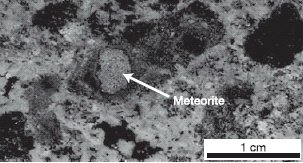Blast from the Past
Pieces of an ancient asteroid that created a 70-kilometer-wide crater survived the blast.
By Emily Sohn
About 144 million years ago, a large asteroid slammed into southern Africa, blasting a crater that measures 70 kilometers (43 miles) across.
Now, an international research team has found intact pieces of this ancient asteroid within the crater. The finding may shake up long-held theories of what happens during such collisions.
 |
|
This sample drilled from rock contains a piece of the asteroid (arrow) that blasted a crater in the Kalahari Desert in Africa 144 million years ago. |
| Wolfgang W.D. Maier et al./Nature |
Asteroids are rocky objects that orbit the sun. If their paths cross Earth’s orbit, they can strike our planet at speeds that average 20 kilometers per second (or 43,200 miles per hour). When large asteroids hit the ground, they produce high temperatures and pressures, carving out bowl-shaped features called craters.
Scientists have known about southern Africa’s large Morokweng crater for a decade. They had detected the crater from the way it warps the planet’s gravitational and magnetic fields in the area. However, the feature is hard to study because it lies buried beneath up to 200 meters (656 feet) of sand in the Kalahari Desert.
When the researchers drilled holes into the ground within the crater, they found evidence that heat from the asteroid’s impact had melted a sheet of rock that was 870 meters (2,850 feet) thick. After the impact, this rock had slowly cooled and hardened again.
Now, in one of the holes, researchers have found an intriguing rock at a depth of 766 meters (2,510 feet). The rock is about the size of a beach ball, and its chemical composition suggests that it came from outer space. It also seems to have come from a different part of the solar system than do the meteorites that fall to Earth today.
Asteroids often melt and combine with Earth rocks around them before hardening again. This asteroid, however, appears untouched on the inside. Smaller pieces of similar rock appear all over the place inside the crater.
“For the first time, it is possible to hold in your hand a . . . piece of a giant asteroid that hit Earth,” says Iain McDonald of Cardiff University in Wales, who was a member of the research team. “This intact fragment may tell us a lot more about the insides of asteroids than we currently know.”
Scientists have long assumed that large asteroids completely melt or vaporize when they hit the ground. The new discovery challenges this assumption.
“This is pretty interesting,” says Frank T. Kyte, a geochemist at the University of California, Los Angeles. “This will make a lot of people rethink the impact process.”—E. Sohn
Going Deeper:
Perkins, Sid. 2006. Blast survivors: Fragments of asteroid found in ancient crater. Science News 169(May 13):292-293. Available at http://www.sciencenews.org/articles/20060513/fob4.asp .
Sohn, Emily. 2005. Killers from outer space. Science News for Kids (May 18). Available at http://www.sciencenewsforkids.org/articles/20050518/Feature1.asp .







